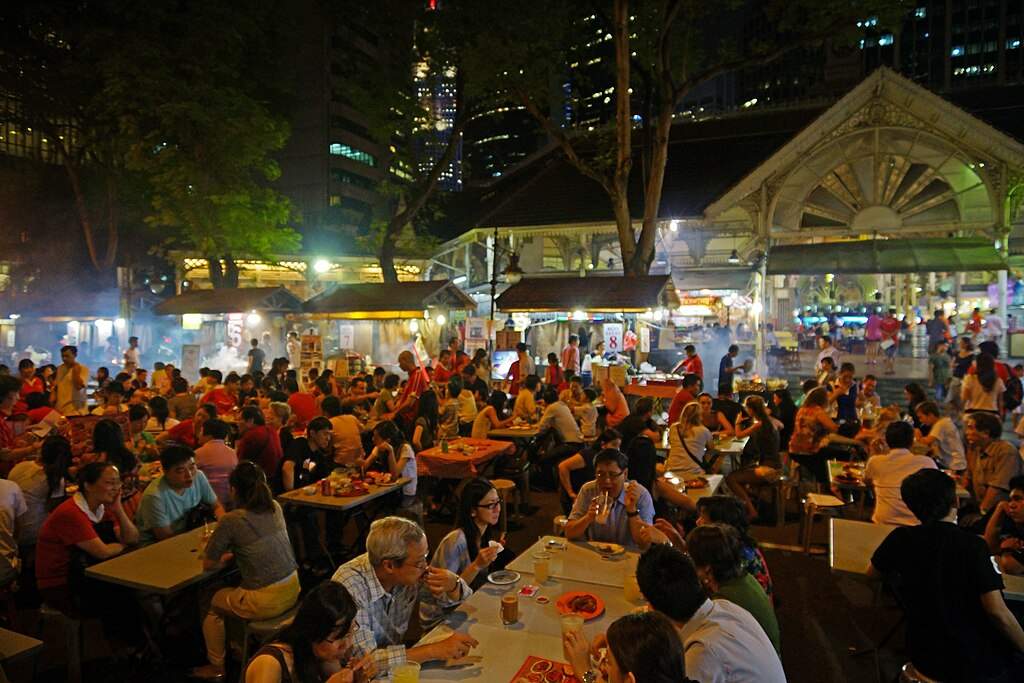Lau Pa Sat: The Honest, Complete Guide to Singapore’s Most Iconic Hawker Centre

Lau Pa Sat at a Glance
Lau Pa Sat (also known as Telok Ayer Market) sits at 18 Raffles Quay in Singapore’s Downtown Core. The hawker centre is famous for two things: its octagonal, cast‑iron pavilion and the nightly Satay Street on Boon Tat Street just outside. It’s busy, occasionally chaotic, and—perhaps this is the charm—worth leaning into.
- Primary vibe: iconic, lively, open‑air satay at night; air‑conditioned variety inside.
- Hours: the complex runs day and night; Satay Street comes alive in the evening and goes late.
- Good for: first‑time visitors, photographers, groups, late‑night eaters, anyone curious about classic Singapore hawker fare in a single, dramatic venue.
If you want exhaustive detail on the satay flow, you can jump to the section below—or, for a deep dive, read a dedicated guide like how to navigate Satay Street at Lau Pa Sat when you’re ready.
A Short History and Architecture You’ll Actually Notice
Long before it became selfie‑famous, Lau Pa Sat began life as a waterfront market in the early 1800s. The version you see today—octagonal, filigreed, and surprisingly airy—was completed in the late 19th century and later protected as a national monument. Step inside, look up: the high central lantern and eight radial aisles make the whole space feel like a calm center to the surrounding city.
It’s Victorian engineering made practical for the tropics: cast‑iron columns, patterned brackets, and broad entrances that encourage cross‑breezes. The clock tower crowns it all. Some people rush to eat and leave; consider a minute of quiet under that roof. It has a way of slowing you down—just enough.
Satay Street, Explained (Clearly)
In the evening, Boon Tat Street closes and transforms. Vendors set up grills, tables spill into the road, and the air fills with a gentle haze that smells like dinner. It’s part night market, part block party. If you arrive around sunset, you’ll see it ramp up in real time—nice for photos, great for easing into the crowd.
How it works (step by step)
- Find (or save) a table number on the street—edge tables catch less smoke; center tables feel more electric.
- Choose your satay vendor. Mixed sets are common; per‑stick ordering is fine if you want control.
- Specify proteins clearly (chicken, beef, mutton, prawn). If you prefer no mix, say so up front.
- Order drinks from the indoor stalls if you want more variety or non‑alcoholic options.
- Expect peak‑hour waits. It’s part of the ritual; bring patience and maybe a small appetizer from inside.
- When food arrives, confirm the count, enjoy the peanut sauce, and keep tissues handy.
Timing, touts, and rain
Most nights build from around 7 pm and stay busy through prime hours; it thins late, especially on weekdays. You’ll encounter friendly (and persistent) touts—choose a stall and stick with it to keep things simple. If it rains, shift under cover; the indoor hall keeps the night salvageable, and the satay can resume when the weather eases.
Sets vs per‑stick
Sets are quick to order and good for groups. Per‑stick lets you fine‑tune the mix or avoid a protein you’re less keen on. If you like prawns, call that out—they sell through, and they grill fast but vanish faster.
Best Stalls at Lau Pa Sat (Starter Route + Deep Picks)
Decision fatigue is real here. Start simple: try two satay vendors for contrast, then add one noodle, one rice, and one sweet. If the queues look long, swap in the alternates below. You’ll get breadth without blowing the evening on indecision.
Starter route for first‑timers
- Satay A: Mixed set (chicken, beef, mutton) to benchmark sauce and char.
- Satay B: Add prawn skewers and compare marinades; choose your winner.
- Noodles: Hokkien mee or laksa for comfort and depth.
- Rice: Chicken rice or roasted meats if you prefer something steadier.
- Sweet/drink: Fresh lime juice, sugarcane, or an ice‑cold beer to reset the palate.
Category picks to look for
- Satay: Look for stalls grilling steadily with good turnover; consistent smoke, quick flips, and caramelized edges are good signs.
- Noodles: Hokkien mee with a touch of prawn stock richness; laksa with balanced coconut and spice; char kway teow with real wok hei.
- Rice: Chicken rice that isn’t overly dry; roasted meats with a glossy finish and clean slice.
- Seafood: Pao fan or simple stir‑fries; ask about spice levels if you prefer a milder plate.
- Indian breads: Prata or thosai if you want crisp edges and a gentler spice ramp.
- Desserts & drinks: Lime juice, sugarcane, chendol, or something fruity to cut the satay richness.
If you’re planning a deeper eater’s run with prices and specific stall numbers, keep a living list handy and update quarterly. For a version you can mirror, see Best stalls at Lau Pa Sat in 2025 and adapt it as things change.
When to Go (By Personality)
- Photographers and ambience‑chasers: Arrive before sunset and stay through blue hour; the lights, smoke, and skyline do the heavy lifting.
- Families and groups: Weeknights before 7:30 pm are kinder; edge tables mean less smoke and easier kid management.
- Minimal‑queue people: Weeknights after 9:30 pm. You trade some buzz for breathing room. Fair deal, most nights.
Weekends are louder and slower. Not bad—just a different energy. If that sounds like your thing, lean into it and order a little more than you think; sharing reduces wait-time frustration.
Diet & Practical Filters
Dietary notes
- Peanuts: Satay sauce contains peanuts; request no sauce or separate plates if needed.
- Halal: Some options are halal; verify signage on individual stalls and ask when in doubt.
- Vegetarian friendly: Look for vegetable noodles, roti with curry sides, and dessert drinks.
Money, seating, and etiquette
- Payments: Many stalls accept cashless, but small notes still help when it’s busy.
- Seating: Keep table numbers visible; seat saving is common—don’t be shy but stay polite.
- Tray return: Use the tray return points; a tiny habit that keeps the place workable for everyone.
If you prefer ultra‑practical, bookmark a shorter companion piece like Satay Street at Lau Pa Sat: how to order, what to pay, and when it’s worth the wait and skim it on the way over.
Getting There & Easy Add‑Ons
MRT makes this simple. Raffles Place and Telok Ayer stations are both a short walk; most people drift in from the CBD side without thinking about it. If it’s raining, stay station‑to‑station underground as long as possible, then make a quick dash.
- Before dinner: A stroll by the river or a quick look at the skyline clears the head and sets the mood.
- After dinner: Boat Quay, Merlion Park, or just loops around the lit towers—it’s all close enough to walk.
If you like pairing place with context, there’s a calmer companion read in the story of Lau Pa Sat: from 1824 market to national monument, which makes the architecture feel… earned.
Photo Ideas & Little Joys
- Inside out: Stand under the central lantern and shoot along a radial aisle; it exaggerates the octagon nicely.
- Clock tower vs skyline: Twilight is best; one step forward or back often fixes distortion more than you’d think.
- Grill lines: Low angle, fast shutter, capture the flare; ask first, smile always.
If the smoke catches your eyes, don’t fight it—shift your seat a few steps. Tiny adjustments change everything out there.
Sample Micro‑Itineraries
The First‑Timer (90 minutes)
- Arrive 6:45 pm and grab an edge table on Boon Tat Street.
- Order a mixed satay set, then fetch lime juice or sugarcane from inside.
- Add one noodle (Hokkien mee or laksa) and one rice (chicken rice) to share.
- Stroll to Merlion Park after; let the night wind de‑smoke your clothes.
The Night Owl (Late)
- Arrive after 9:30 pm on a weekday.
- Per‑stick satay order for precision; add prawns if available.
- Finish with something sweet and a slow walk past Boat Quay lights.
The Architecture‑Curious (Layered)
- Start inside: look up at the lantern, note the eight aisles, the cast‑iron work.
- Photograph the clock tower at blue hour.
- Eat after 8 pm as the crowd loosens; compare two stalls and call your winner.
Quick FAQs About Lau Pa Sat
Is Lau Pa Sat worth it if I hate crowds?
Yes—just time it. Weeknights late are calmer. You keep the magic and skip most of the jostling.
What if it rains?
Shift indoors and pause. Street seating may reopen after the shower; worst case, you still eat well under that beautiful roof.
Is it all satay?
No. Inside is a spectrum: noodles, rice, seafood, Indian breads, and desserts. Satay is the showpiece; the hall is the pantry.
How do I link this with other planning reads?
For tactics, use the Satay Street guide. For food picks, keep the best stalls at Lau Pa Sat in 2025 handy. For depth, read the history and architecture story.








